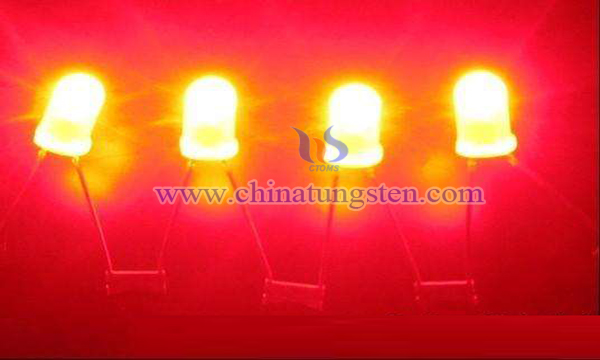Tungstate Red LED Phosphor
- Details
- Category: Tungsten Information
- Published on Friday, 05 April 2019 20:23
In 1993, the advent of LED brought a significant revolution in the field of lighting. Then in 1996, the first white LED solid light source was developed by using GaN-LED chip and YAG: Ce3+ phosphor to emit white light. Since then, white LED has surpassed incandescent lamp, fluorescent lamp and other lighting sources with the advantages of small size, low calorific value, low power consumption, long life, fast reaction speed, environmental protection and planar packaging.

At present, there are three main ways to realize white LED: one is to excite phosphor with the light emitted by the LED chip, and the light emitted by the chip and phosphor is mixed to form white light, i.e. phosphor coating light conversion method; the other is to prepare white LED components using red, green and blue LED, i.e. multi-color LED combination method; the third is to use multiple active layers to make the LED directly white light, i.e. multi-quantum well method. Among them, the phosphor coating light conversion method is one of the main ways to produce white LED. At present, most commercialized products are manufactured by this method.
In this method, phosphor as a light conversion material plays an important role, which directly affects the luminous efficiency, service life, color rendering index and color temperature of white LED products. In the research of phosphors for white LED, the preparation of green powder and yellow powder and their luminescent properties have reached a mature stage. However, the luminescent efficiency and stability of red powder can not be compared with other powders.
The red LED phosphor based on tungstate system has such remarkable characteristics as above, and it has become the main material of red phosphor for LED at present. For example, researchers have prepared tungstate Red Phosphors by sol-gel combustion method, and prepared red tungstate phosphors with good stability, high purity and high luminous efficiency. They are very suitable for white LED applications. The preparation process includes:
Step 1: NaNO3, Mg(NO3)2·6H2O, Gd (NO3)3·6H2O, Eu(NO3)3·6H2O and NH4·5H5·[H2(WO4)6]H2O were weighed respectively, then the five salts were dissolved in deionized water to form five salt solutions, and finally the five salt solutions were mixed together to form a mixed solution.
Step 2, first of all, the citric acid is added to the mixed solution obtained in step 1, stirring to form sol; then the sol is heated in a constant temperature water bath to form a wet gel; finally, the dried gel is dried.
Step 3, calcined dry gel into muffle furnace and prepare tungstate red phosphor.
The red tungstate phosphor prepared by sol-gel combustion is a new red phosphor doped with europium. The red phosphor has perovskite structure. In this structure, the Eu3+ ions occupy no symmetry in the lattice. In addition, by adjusting the doping amount and technological parameters of rare earth europium ions, the monodisperse spherical powder with high purity, uniform doping and controllable particle size can be prepared. It has high stability, high color purity and can be effectively stimulated by near ultraviolet and blue light. It can meet the requirements of white LED for red phosphor, improve the luminous efficiency and color rendering index of white LED products, and has economic and social benefits.
- Tungsten Oxide Manufacturer & Supplier, Chinatungsten Online: www.tungsten-oxide.com
- Tungsten News & Prices of China Tungsten Industry Association: www.ctia.com.cn
- Molybdenum News & Price: news.molybdenum.com.cn
- Tel.: 86 592 5129696; Fax: 86 592 5129797; Email: sales@chinatungsten.com



 sales@chinatungsten.com
sales@chinatungsten.com